On the Effect of Flexibility on the Dynamics of a Suspended Payload Carried by a Quadrotor
Abstract
1. Introduction
2. Materials and Methods
Equation of Motion
3. Controller Development
3.1. Altitude Control Design
3.1.1. Adaptive Altitude Control Design
3.1.2. Stability Analysis
3.2. Attitude Control Design
3.3. Reduced-Dimension Observer (RDO)
4. Results and Discussion
4.1. First Trajectory Configuration (Rectangular)
4.1.1. Elastic Attachment Influence
4.1.2. Vibration Characteristics
4.2. Second Trajectory Configuration (Circular)
4.3. Reduced-Dimension Observer (RDO)
5. Conclusions
Author Contributions
Funding
Institutional Review Board Statement
Informed Consent Statement
Data Availability Statement
Acknowledgments
Conflicts of Interest
Abbreviations
| UAV | Unmanned Aerial Vehicle |
| GPS | Global Positioning System |
| SMC | Sliding Mode Control |
| GESO | Generalized Extended State Observer |
| UAS | Unmanned Aircraft System |
| IMU | Inertial Measurement Unit |
| DO | Disturbance Observer |
| ESO | Extended State Observer |
| PID | Proportional Integral and Derivative |
| RMS | Root Mean Square |
| LQR | Linear Quadratic Regulator |
Appendix A. Load-Correcting Factor


Appendix B. Reduced-Dimension Observer Matrices
References
- Hii, M.; Courtney, P.; Royall, P. An Evaluation of the Delivery of Medicines Using Drones. Drones 2019, 3, 52. [Google Scholar] [CrossRef]
- Malik, R.; Roy, I. Probing the mechanism of insulin aggregation during agitation. Int. J. Pharm. 2011, 413, 73–80. [Google Scholar] [CrossRef] [PubMed]
- Phan, C.; Liu, H. Dynamic Mapping of Forest Fire Fronts Using Multiple Unmanned Aerial Vehicles. In Proceedings of the AIAA Guidance, Navigation, and Control Conference, Toronto, ON, Canada, 2–5 August 2010. [Google Scholar] [CrossRef]
- Kim, J.; Kim, S.; Ju, C.; Son, H.I. Unmanned Aerial Vehicles in Agriculture: A Review of Perspective of Platform, Control, and Applications. IEEE Access 2019, 7, 105100–105115. [Google Scholar] [CrossRef]
- Lin, Z.; Liu, H.H.T.; Wotton, M. Kalman Filter-Based Large-Scale Wildfire Monitoring with a System of UAVs. IEEE Trans. Ind. Electron. 2018, 66, 606–615. [Google Scholar] [CrossRef]
- Ju, C.; Son, H.I. Multiple UAV Systems for Agricultural Applications: Control, Implementation, and Evaluation. Electronics 2018, 7, 162. [Google Scholar] [CrossRef]
- Segui, M.; Sugar Gabor, O.; Koreanschi, A.; Botez, R.M. Morphing wing application on Hydra Technologies UAS-S4 IASTED Modelling. In Proceedings of the IASTED Modelling, Identification and Control 2017 Conference, Innsbruck, Austria, 20–21 February 2017. [Google Scholar]
- Puri, A. A Survey of Unmanned Aerial Vehicles (UAV) for Traffic Surveillance; Department of Computer Science and Engineering, University of South Florida: Tampa, FL, USA, 2005; pp. 1–29. [Google Scholar]
- Kingston, D.; Rasmussen, S.; Humphrey, L. Automated UAV tasks for search and surveillance. In Proceedings of the 2016 IEEE Conference on Control Applications (CCA), Buenos Aires, Argentina, 19–22 September 2016; pp. 1–8. [Google Scholar] [CrossRef]
- Geronel, R.S.; Bueno, D.D. Trajectory Tracking of a Quadcopter with an Attached Payload Mass under External Disturbances. In Proceedings of the 2021 14th IEEE International Conference on Industry Applications (INDUSCON), São Paulo, Brazil, 15–18 August 2021; pp. 1288–1295. [Google Scholar] [CrossRef]
- Yanez, B.H.; Beltran, C.F.; Tapia, O.R.; Kuitche, M.A.J.; Botez, R.M. Generalized extended state observer based-control for active suppression of forced vibrations in a multi-rotor unmanned vehicle. In Proceedings of the 26th International Congress on Sound and Vibration (ICSV), Montreal, QC, Canada, 7–11 July 2019. [Google Scholar]
- Botez, R.M.; Boustani, I.; Vayani, N. Active Vibration Control for a Flexible Aircraft Equipped with Gust Load Control System. In Proceedings of the 6th International Congress on Sound and Vibration, Copenhagen, Denmark, 5–8 July 1999; pp. 1731–1738. [Google Scholar]
- Scalea, J.R.; Restaino, S.; Scassero, M.; Bartlett, S.T.; Wereley, N. The final frontier? Exploring organ transportation by drone. Am. J. Transplant. 2018, 19, 962–964. [Google Scholar] [CrossRef]
- Oakey, A.; Waters, T.; Zhu, W.; Royall, P.; Cherrett, T.; Courtney, P.; Majoe, D.; Jelev, N. Quantifying the Effects of Vibration on Medicines in Transit Caused by Fixed-Wing and Multi-Copter Drones. Drones 2021, 5, 22. [Google Scholar] [CrossRef]
- Arizaga, J.M.; Castaneda, H.; Castillo, P. Payload Swing Attenuation of a Fully-Actuated Hexacopter via Extended High Gain Observer Based Adaptive Sliding Control. In Proceedings of the 2021 International Conference on Unmanned Aircraft Systems (ICUAS), Athens, Greece, 15–18 June 2021; pp. 901–908. [Google Scholar] [CrossRef]
- Carbaja, F.B.; Badillo, H.Y.; Olvera, R.T.; Contreras, A.F.; Gonzalez, A.V.; Garcia, I.L. On Active Vibration Absorption in Motion Control of a Quadrotor UAV. Mathematics 2022, 10, 235. [Google Scholar]
- Alkomy, H.; Shan, J. Vibration reduction of a quadrotor with a cable-suspended payload using polynomial trajectories. Nonlinear Dyn. 2021, 104, 3713–3735. [Google Scholar] [CrossRef]
- Ullah, N.; Sami, I.; Shaoping, W.; Mukhtar, H.; Wang, X.; Chowdhury, M.S.; Techato, K. A computationally efficient adaptive robust control scheme for a quad-rotor transporting cable-suspended payloads. Proc. Inst. Mech. Eng. Part G J. Aerosp. Eng. 2022, 236, 379–395. [Google Scholar] [CrossRef]
- Bingöl, O.; Güzey, H.M. Neuro sliding mode control of quadrotor UAVs carrying suspended payload. Adv. Robot. 2021, 35, 255–266. [Google Scholar] [CrossRef]
- Pizetta, I.H.B.; Brandao, A.S.; Sarcinelli-Filho, M. Modelling and control of a PVTOL quadrotor carrying a suspended load. In Proceedings of the 2015 International Conference on Unmanned Aircraft Systems, ICUAS, Denver, CO, USA, 9–12 June 2015; pp. 444–450. [Google Scholar]
- Zhou, X.; Liu, R.; Zhang, J.; Zhang, X. Stabilization of a Quadrotor with Uncertain Suspended Load Using Sliding Mode Control. In Proceedings of the ASME 2016 International Design Engineering Technical Conferences and Computers and Information in Engineering Conference, Charlotte, NC, USA, 21–24 August 2016. [Google Scholar] [CrossRef]
- Pounds, P.E.I.; Bersak, D.R.; Dollar, A.M. Stability of small scale UAV helicopters and quadrotors with added payload mass under PID control. Auto. Robots 2012, 33, 129–142. [Google Scholar] [CrossRef]
- Kusznir, T.; Smoczek, J. Sliding Mode-Based Control of a UAV Quadrotor for Suppressing the Cable-Suspended Payload Vibration. J. Control Sci. Eng. 2020, 2020, 5058039. [Google Scholar] [CrossRef]
- Guerrero-Sánchez, M.; Lozano, R.; Castillo, P.; Hernández-González, O.; García-Beltrán, C.; Valencia-Palomo, G. Nonlinear control strategies for a UAV carrying a load with swing attenuation. Appl. Math. Model. 2020, 91, 709–722. [Google Scholar] [CrossRef]
- Klausen, K.; Fossen, T.I.; Johansen, T.A. Nonlinear Control with Swing Damping of a Multirotor UAV with Suspended Load. J. Intell. Robot. Syst. 2017, 88, 379–394. [Google Scholar] [CrossRef]
- Palunko, I.; Fierro, R.; Cruz, P. Trajectory generation for swing-free maneuvers of a quadrotor with suspended payload: A dynamic programming approach. In Proceedings of the 2012 IEEE International Conference on Robotics and Automation, Saint Paul, MN, USA, 14–18 May 2012; pp. 2691–2697. [Google Scholar] [CrossRef]
- Klausen, K.; Fossen, T.I.; Johansen, T. Nonlinear Control of a Multirotor UAV with Suspended Load. In Proceedings of the 2015 International Conference on Unmanned Aircraft Systems (ICUAS), Denver, CO, USA, 9–12 June 2015; pp. 1–9. [Google Scholar]
- Wu, Y.; Xie, Y.; Li, S. Parameter Adaptive Control for a Quadrotor with a Suspended Unknown Payload under External Disturbance. IEEE Access 2021, 9, 139958–139967. [Google Scholar] [CrossRef]
- Patron, R.F.; Kessaci, A.; Botez, R. Flight trajectories optimization under the influence of winds using genetic algorithms. In Proceedings of the ASME 2014 International Mechanical Engineering Congress and Exposition, Montreal, QC, Canada, 14–20 November 2014. [Google Scholar] [CrossRef]
- Badillo, H.Y.; Botez, R.M. Disturbance Rejection in Longitudinal Control for the UAS-S4 Ehecatl Design. In Proceedings of the AIAA Aviation 2020 Forum, Virtual Event, 15–19 June 2020. [Google Scholar]
- Kuitche, M.A.; Botez, R.M.; Guillemin, A.; Communier, D. Aerodynamic Modeling of Unmanned Aerial System through Nonlinear Vortex Lattice Method, Computational Fluid Dynamics and Experimental Validation—Application to the UAS-S45 Bzlaam: Part 1. INCAS Bull. 2020, 12, 91–103. [Google Scholar] [CrossRef]
- Kuitche, M.A.; Botez, R.M.; Guillemin, A.; Communier, D. Aerodynamic Modeling of Unmanned Aerial System through Nonlinear Vortex Lattice Method, Computational Fluid Dynamics and Experimental Validation—Application to the UAS-S45 Bzlaam: Part 2. INCAS Bull. 2020, 12, 99–115. [Google Scholar] [CrossRef]
- Gabor, O.; Koreanschi, A.; Botez, R. Analysis of UAS-S4 Éhecatl aerodynamic performance improvement using several configurations of a morphing wing technology. Aeronaut. J. 2016, 120, 1337–1364. [Google Scholar] [CrossRef]
- Tondji, Y.; Botez, R.M. Semi-empirical estimation and experimental method for determining inertial properties of the Unmanned Aerial System—UAS-S4 of Hydra Technologies. Aeronaut. J. 2017, 121, 1648–1682. [Google Scholar] [CrossRef]
- Gabor, O.S.; Simon, A.; Koreanschi, A.; Botez, R.M. Aerodynamic performance improvement of the UAS-S4 Éhecatl morphing airfoil using novel optimization techniques. Proc. Inst. Mech. Eng. Part G J. Aerosp. Eng. 2015, 230, 1164–1180. [Google Scholar] [CrossRef]
- Botez, R.M. Morphing Wing, UAV and Aircraft Multidisciplinary Studies at the Laboratory of Applied Research in Active Controls, Avionics and AeroServoElasticity LARCASE. Aerosp. J. 2018, 14, 1–11. [Google Scholar]
- Wang, B.; Yu, X.; Mu, L.; Zhang, Y. Disturbance observer-based adaptive fault-tolerant control for a quadrotor helicopter subject to parametric uncertainties and external disturbances. Mech. Syst. Signal Process. 2018, 120, 727–743. [Google Scholar] [CrossRef]
- Fan, J.; Zhang, Y.; Zheng, Z. Adaptive Observer-Based Integrated Fault Diagnosis and Fault-Tolerant Control Systems against Actuator Faults and Saturation. J. Dyn. Syst. Meas. Control 2013, 135, 041008. [Google Scholar] [CrossRef]
- Guo, K.; Jia, J.; Yu, X.; Guo, L.; Xie, L. Multiple observers based anti-disturbance control for a quadrotor UAV against payload and wind disturbances. Control Eng. Pract. 2020, 102, 104560. [Google Scholar] [CrossRef]
- Cestino, E.; Frulla, G.; Marzocca, P. A Reduced Order Model for the Aeroelastic Analysis of Flexible Wings. SAE Int. J. Aerosp. 2013, 6, 447–458. [Google Scholar] [CrossRef]
- Cassaro, M.; Battipede, M.; Marzocca, P.; Cestino, E.; Behal, A. 1 Adaptive Flutter Suppression Control Strategy for Highly Flexible Structure. SAE Int. J. Aerosp. 2013, 6, 693–702. [Google Scholar] [CrossRef]
- Findlay, E.; Forbes, J.; Liu, H.; de Ruiter, A.; Damaren, C.; Lee, J. Investigation of Active Vibration Suppression of a Flexible Satellite using Magnetic Attitude Control. In Proceedings of the AIAA Guidance, Navigation, and Control Conference, Portland, OR, USA, 8–11 August 2011. [Google Scholar] [CrossRef][Green Version]
- Haghighat, S.; Liu, H.H.T.; Martins, J. Model-Predictive Gust Load Alleviation Controller for a Highly Flexible Aircraft. J. Guid. Control. Dyn. 2012, 35, 1751–1766. [Google Scholar] [CrossRef]
- Tuzcu, I.; Marzocca, P.; Cestino, E.; Romeo, G.; Frulla, G. Stability and Control of a High-Altitude, Long-Endurance UAV. J. Guid. Control. Dyn. 2007, 30, 713–721. [Google Scholar] [CrossRef]
- Estevez, J.; Lopez-Guede, J.; Garate, G.; Graña, M. A Hybrid Control Approach for the Swing Free Transportation of a Double Pendulum with a Quadrotor. Appl. Sci. 2021, 11, 5487. [Google Scholar] [CrossRef]
- Beal, T.R. Digital simulation of atmospheric turbulence for Dryden and von Karman models. J. Guid. Control. Dyn. 1993, 16, 132–138. [Google Scholar] [CrossRef]
- Utkin, V.I. Sliding Modes in Control and Optimization; Springer: Berlin/Heidelberg, Germany, 1992. [Google Scholar] [CrossRef]
- Zheng, E.-H.; Xiong, J.-J.; Luo, J.-L. Second order sliding mode control for a quadrotor UAV. ISA Trans. 2014, 53, 1350–1356. [Google Scholar] [CrossRef] [PubMed]
- Zhong, Y.; Zhang, Y.; Zhang, W.; Zuo, J.; Zhan, H. Robust Actuator Fault Detection and Diagnosis for a Quadrotor UAV with External Disturbances. IEEE Access 2018, 6, 48169–48180. [Google Scholar] [CrossRef]
- Vahdanipour, M.; Khodabandeh, M. Adaptive fractional order sliding mode control for a quadrotor with a varying load. Aerosp. Sci. Technol. 2019, 86, 737–747. [Google Scholar] [CrossRef]
- Yuan, X.; Ren, X.; Zhu, B.; Zheng, Z.; Zuo, Z. Robust H∞ Control for Hovering of a Quadrotor UAV with Slung Load. In Proceedings of the 12th Asian Control Conference (ASCC), Kitakyushu, Japan, 9–12 June 2019; pp. 1–6. [Google Scholar]
- Luenberger, D. An introduction to observers. IEEE Trans. Autom. Control 1971, 16, 596–602. [Google Scholar] [CrossRef]
- Ogata, K.; Brewer, J.W. Modern Control Engineering; Pearson: London, UK, 2010. [Google Scholar]
- Faust, A.; Palunko, I.; Cruz, P.; Fierro, R.; Tapia, L. Learning swing-free trajectories for UAVs with a suspended load. In Proceedings of the 2013 IEEE International Conference on Robotics and Automation, Karlsruhe, Germany, 6–10 May 2013; pp. 4902–4909. [Google Scholar] [CrossRef]
- Barikbin, B.; Fakharian, A. Trajectory tracking for quadrotor UAV transporting cable-suspended payload in wind presence. Trans. Inst. Meas. Control 2018, 41, 1243–1255. [Google Scholar] [CrossRef]
- Shiang, W.J.; Cannon, D.; Gorman, J. Optimal Force Distributbion Applied to a Robotic Crane with Flexible Cables. In Proceedings of the 2000 ICRA. Millennium Conference, IEEE International Conference on Robotics and Automation, Symposia Proceedings (Cat. No.00CH37065), San Francisco, CA, USA, 24–28 April 2020; Volume 2, pp. 1948–1954. [Google Scholar]
- Fatehi, M.H.; Eghtesad, M.; Amjadifard, R. Modelling and Control of an Overhead Crane System with a Flexible Cable and Large Swing Angle. J. Low Freq. Noise Vib. Act. Control 2014, 33, 395–409. [Google Scholar] [CrossRef]
- Kotaru, P.; Wu, G.; Sreenath, K. Dynamics and control of a quadrotor with a payload suspended through an elastic cable. In Proceedings of the 2017 American Control Conference (ACC), Seattle, WA, USA, 24–26 May 2017; pp. 3906–3913. [Google Scholar] [CrossRef]
- Scalea, J.R.; Restaino, S.; Scassero, M.; Blankenship, G.; Bartlett, S.T.; Wereley, N. An Initial Investigation of Unmanned Aircraft Systems (UAS) and Real-Time Organ Status Measurement for Transporting Human Organs. IEEE J. Transl. Eng. Health Med. 2018, 6, 1–7. [Google Scholar] [CrossRef]
- Geronel, R.S.; Dowell, E.H.; Bueno, D.D. Estimating the oscillation frequency of a payload mass on quadcopter in non-autonomous flight. J. Vib. Control 2021, 2021, 1–15. [Google Scholar] [CrossRef]
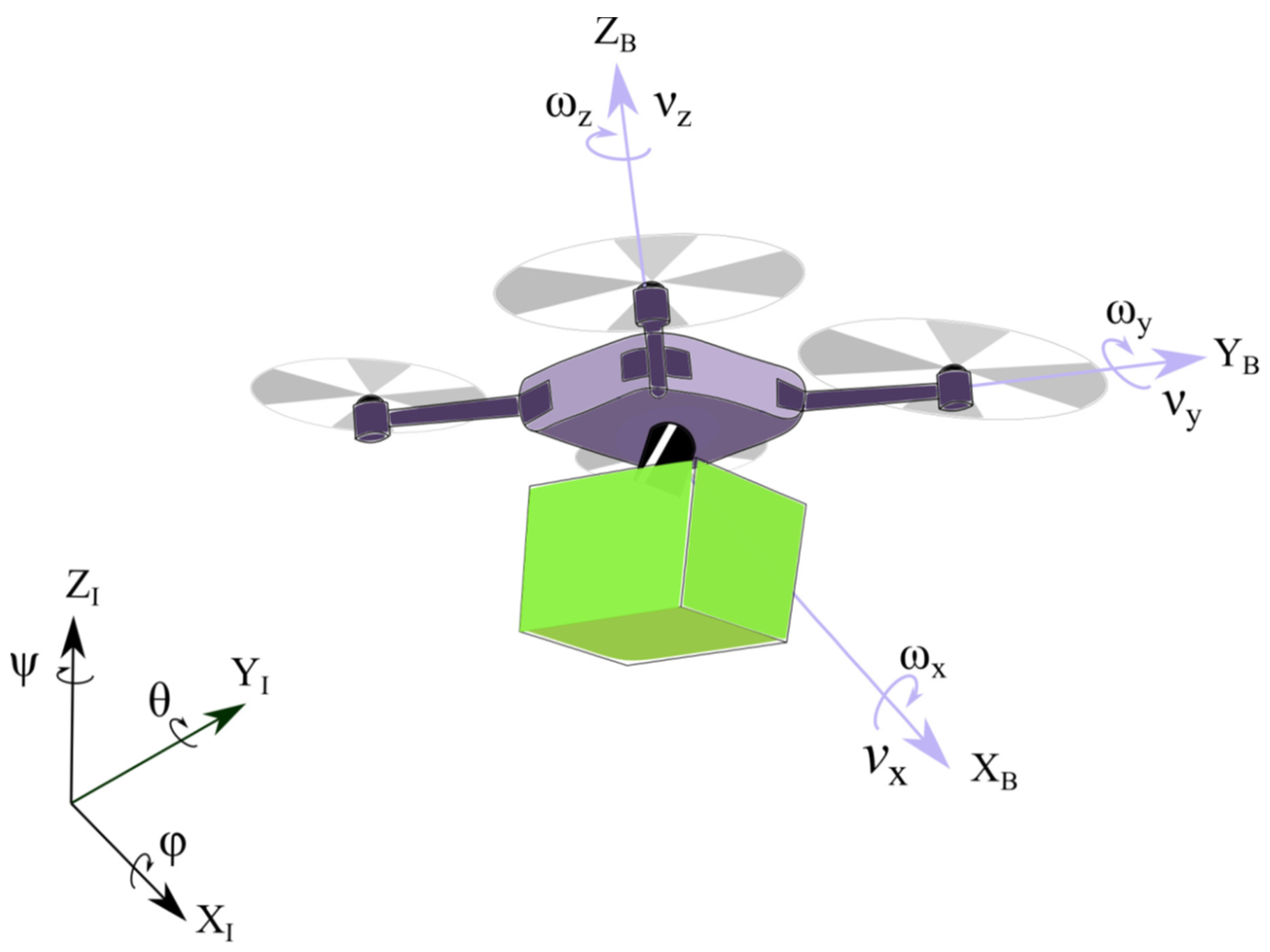
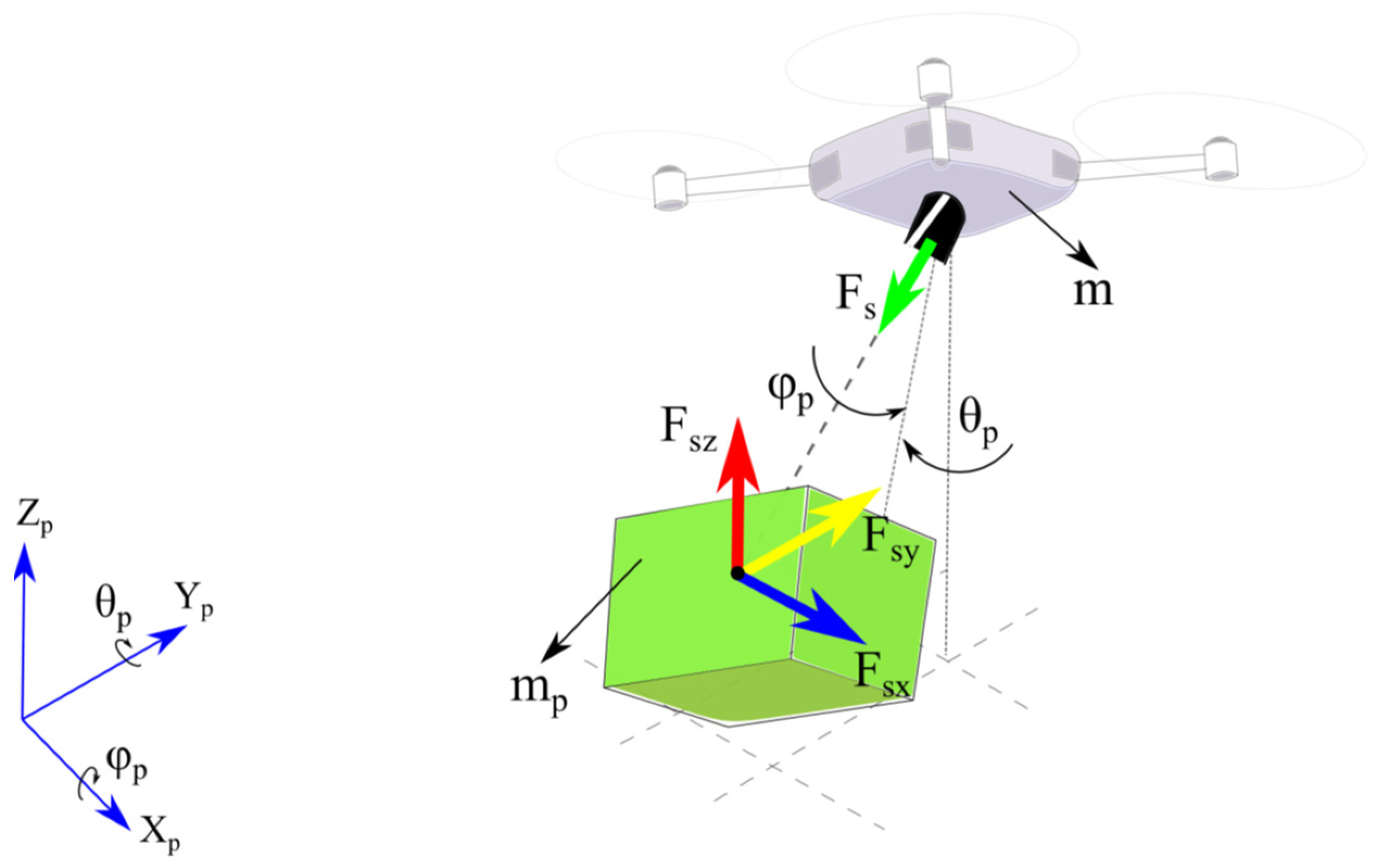
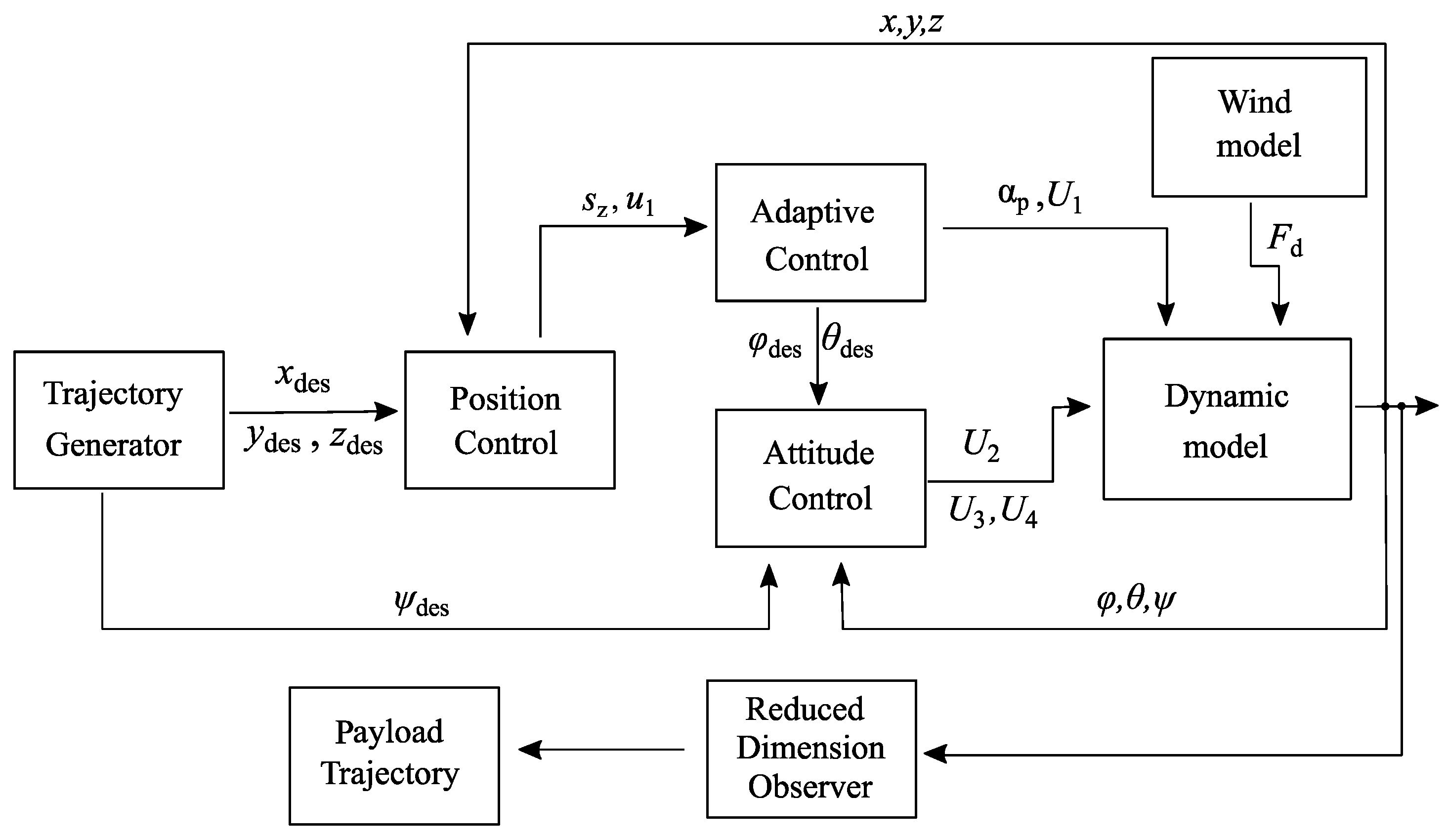
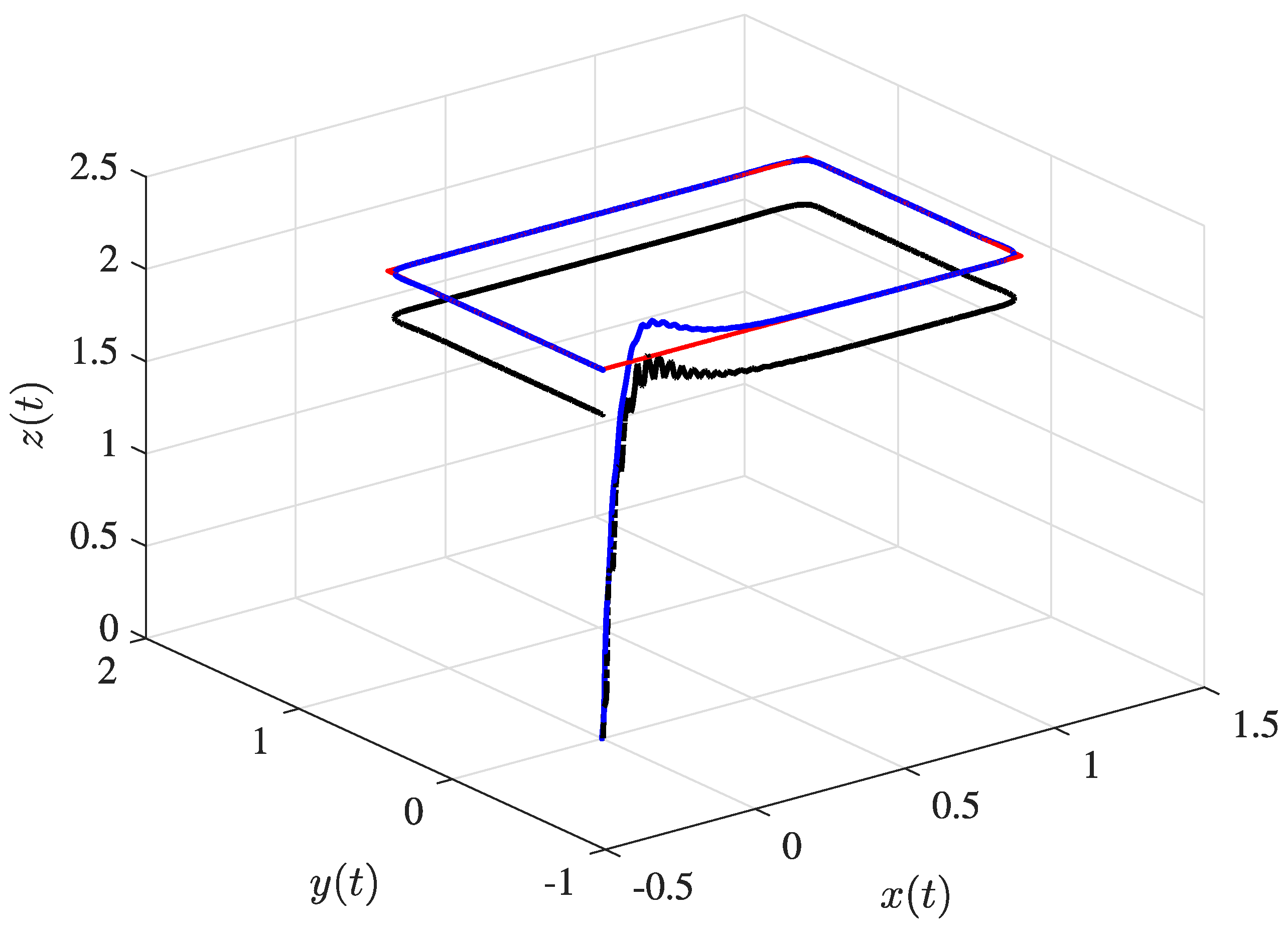
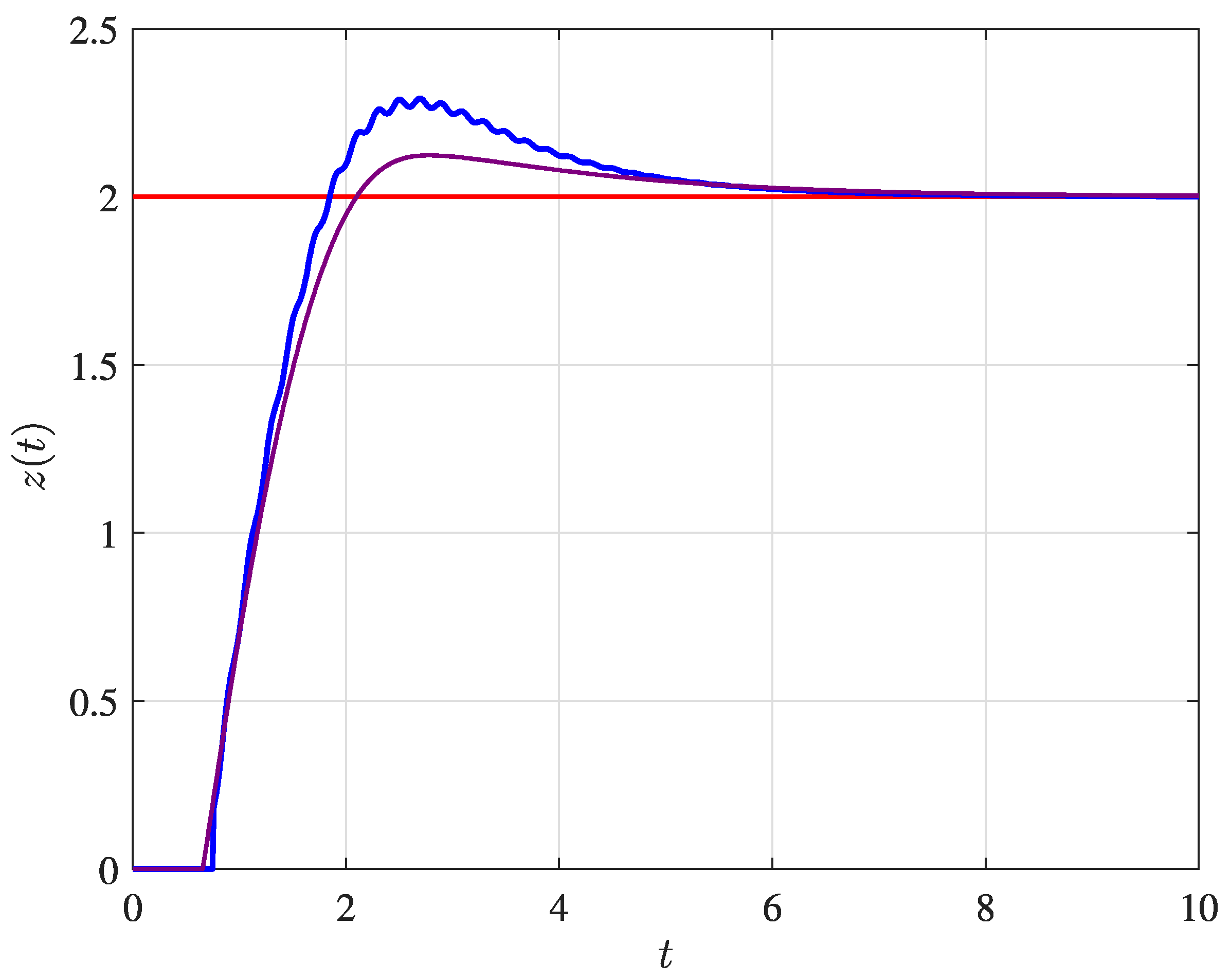
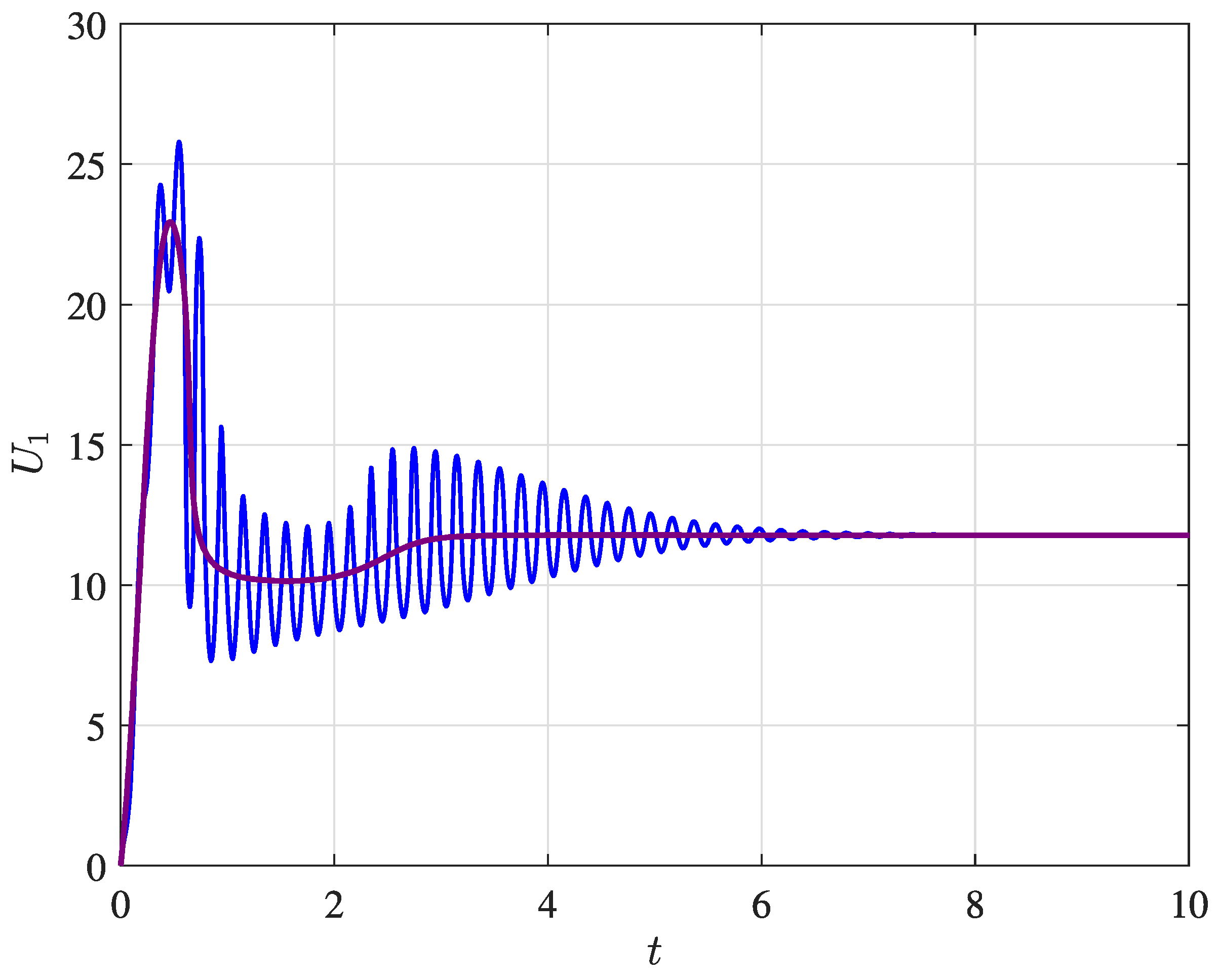
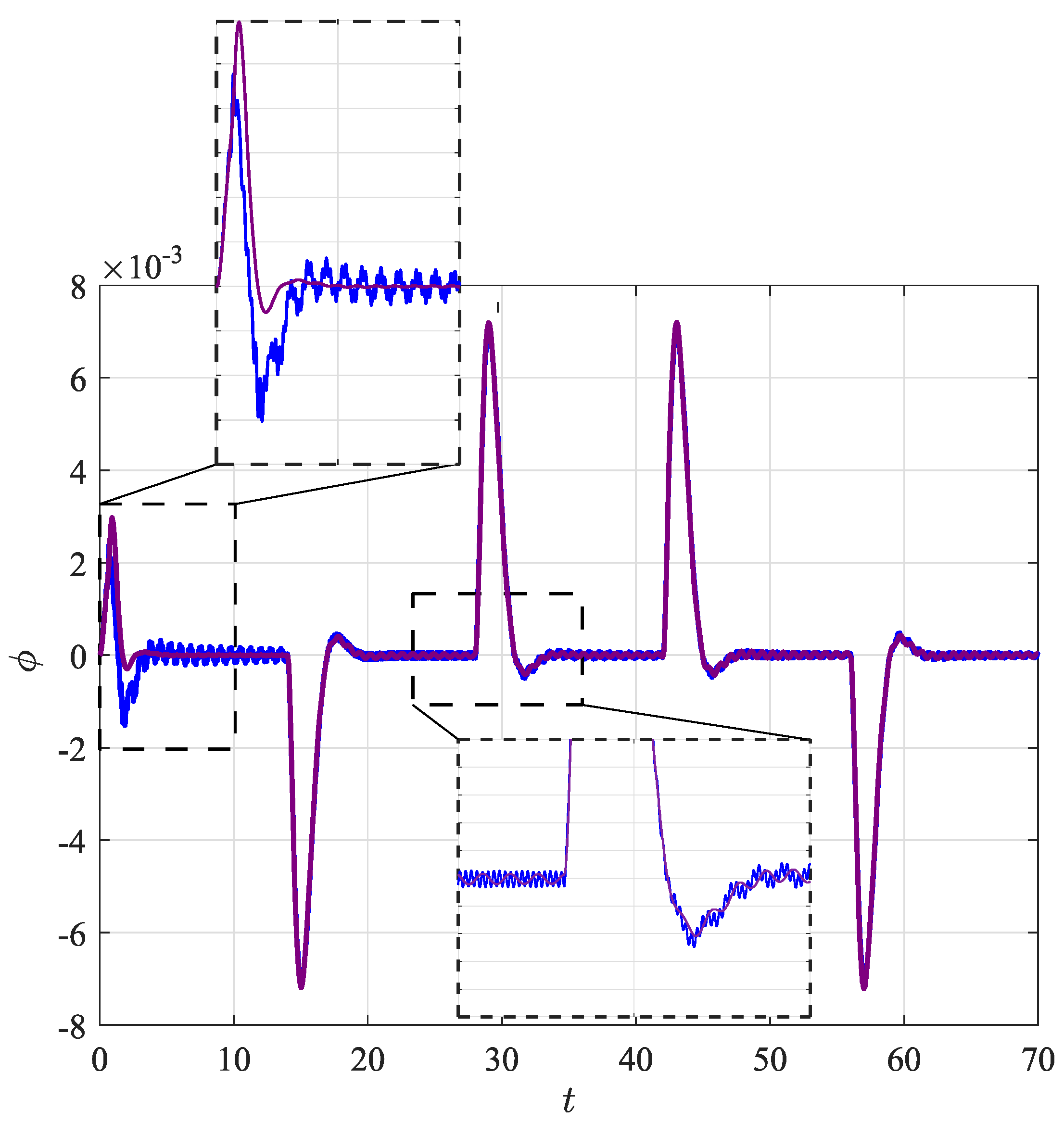
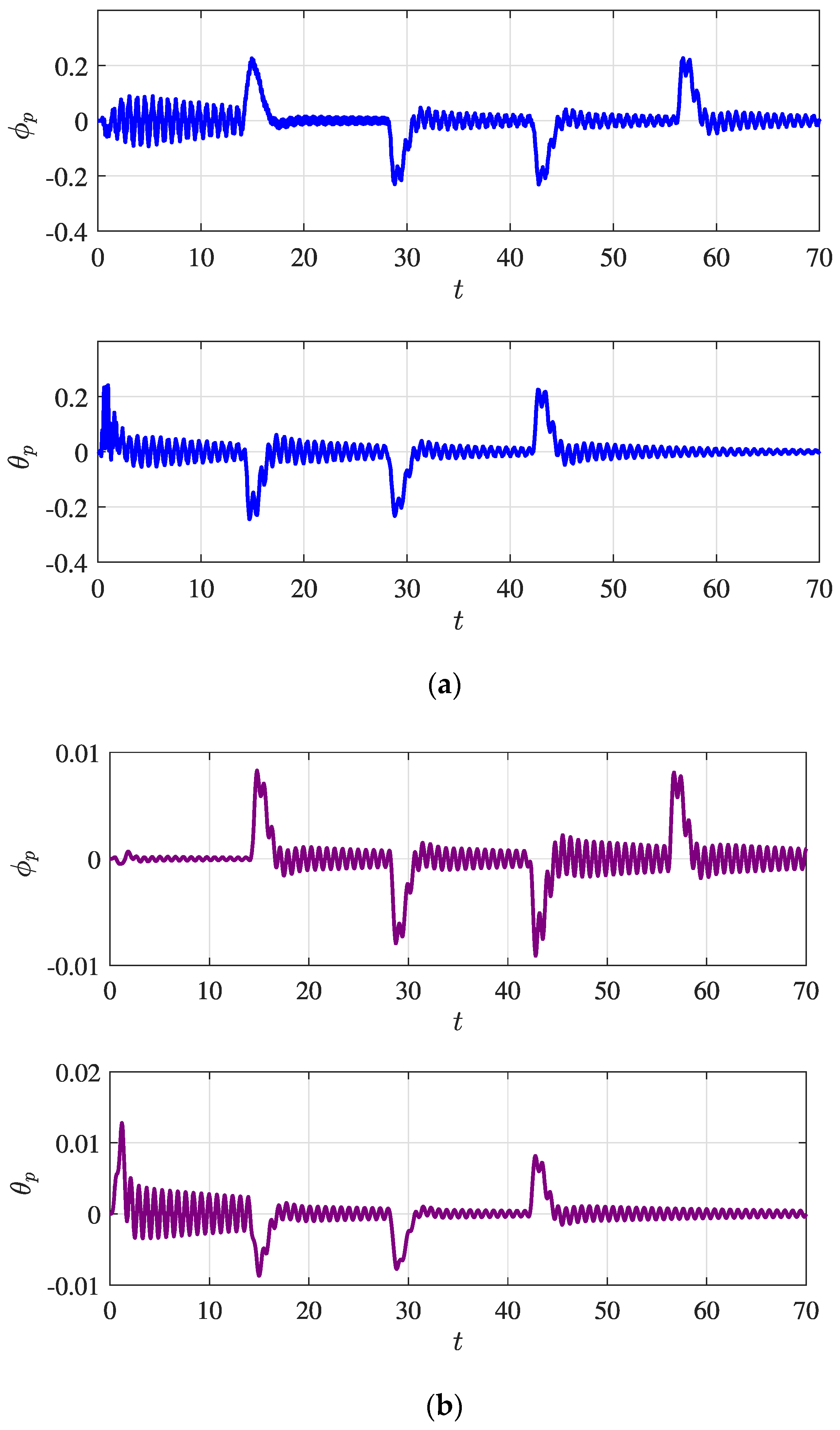
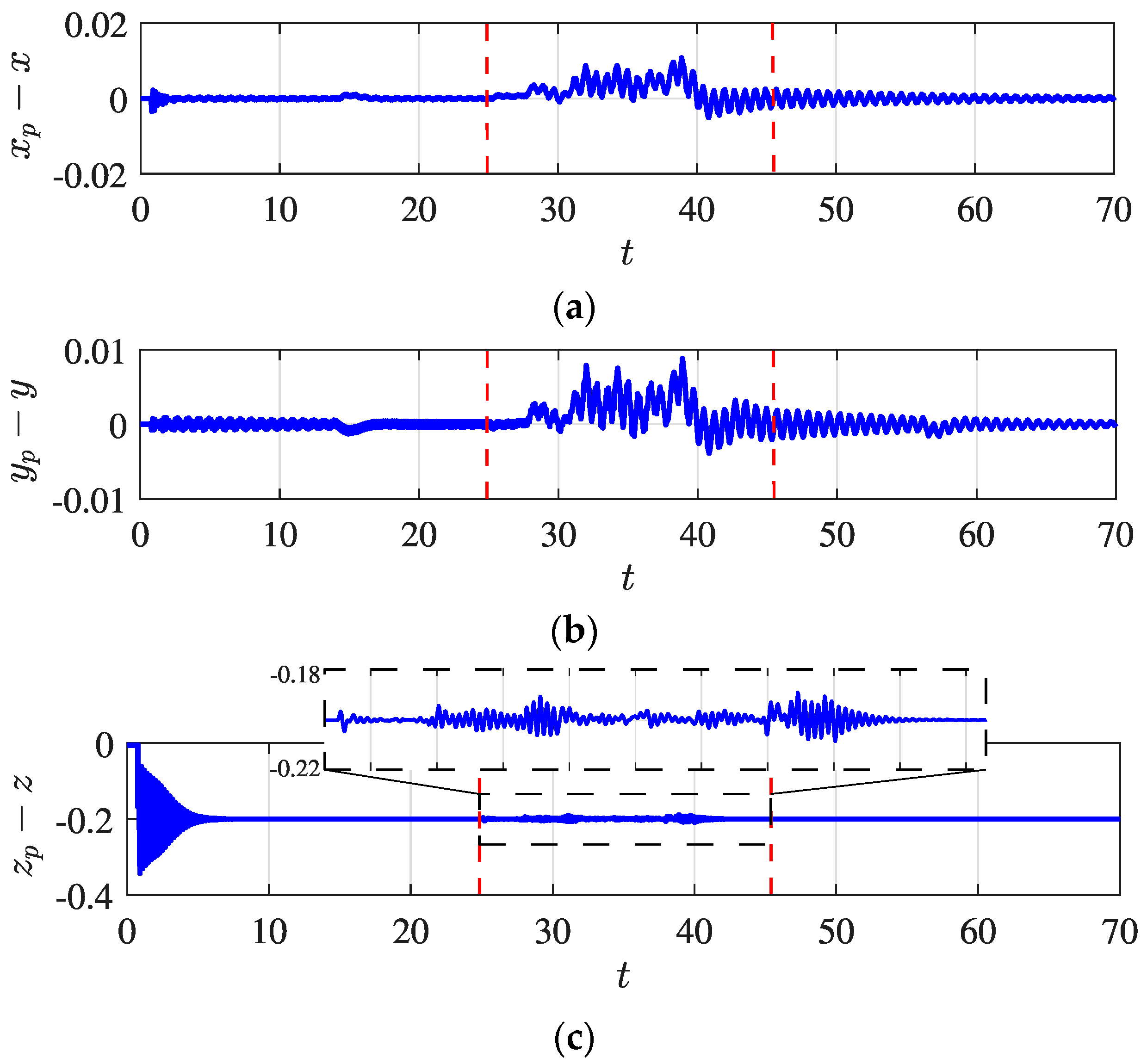
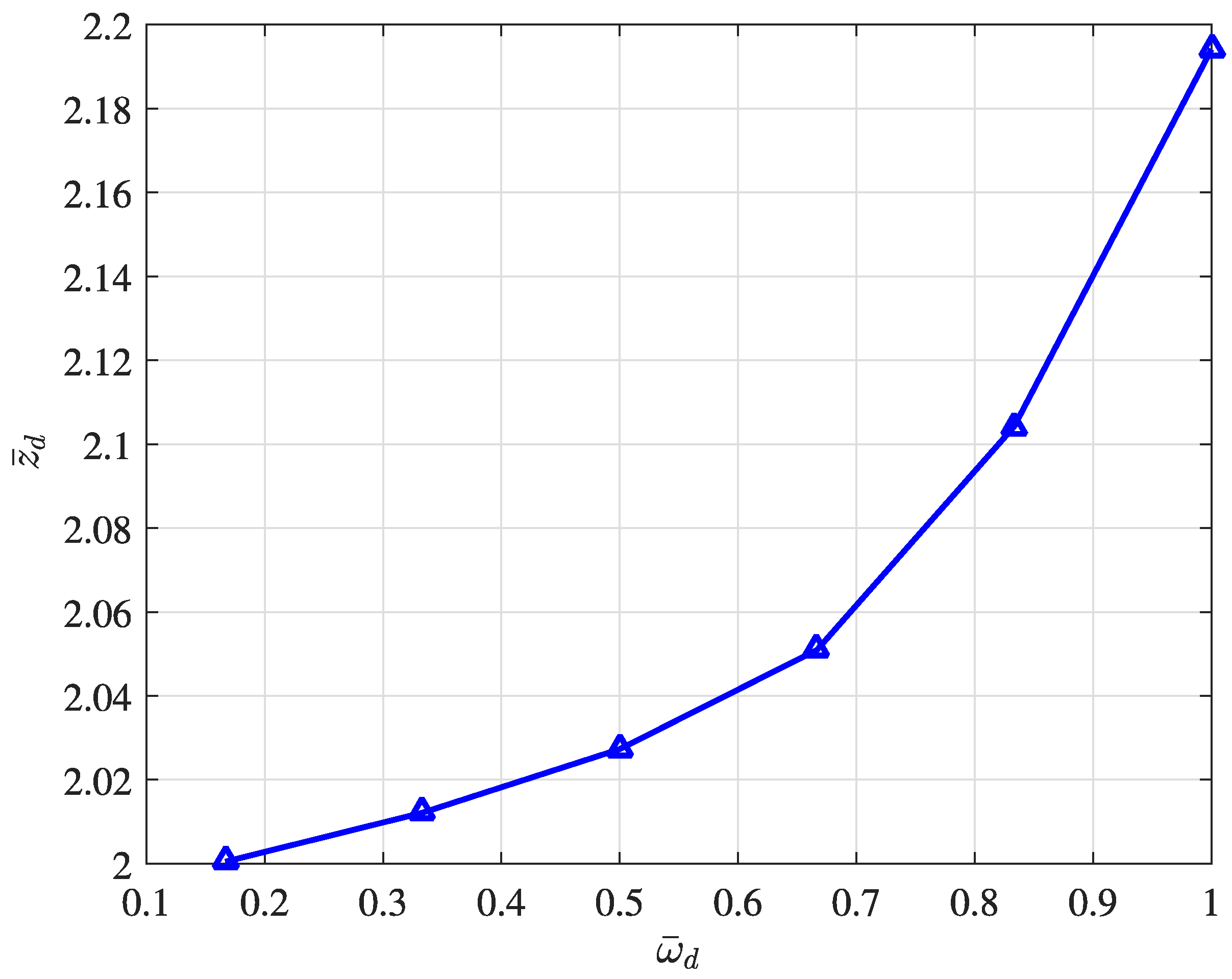
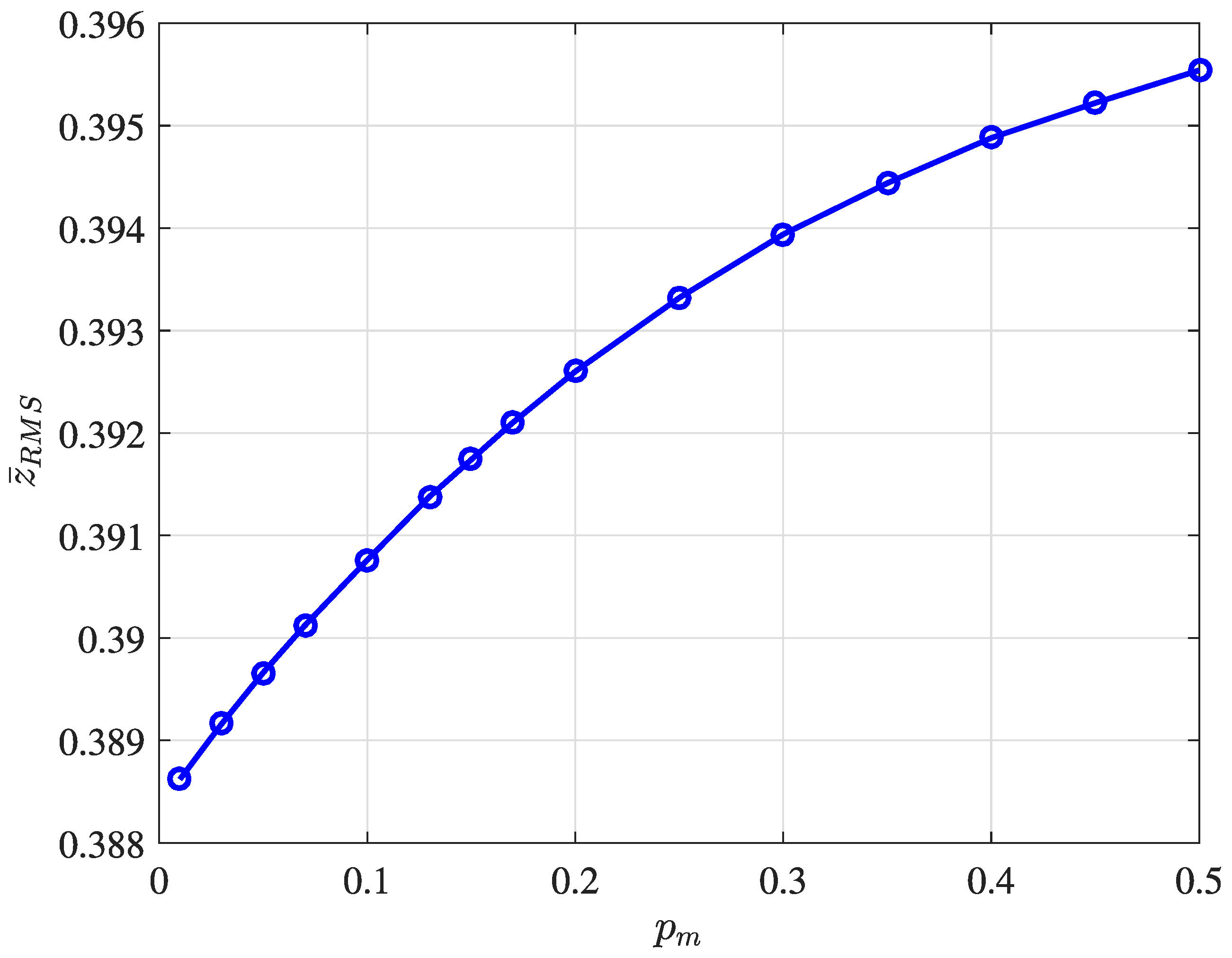
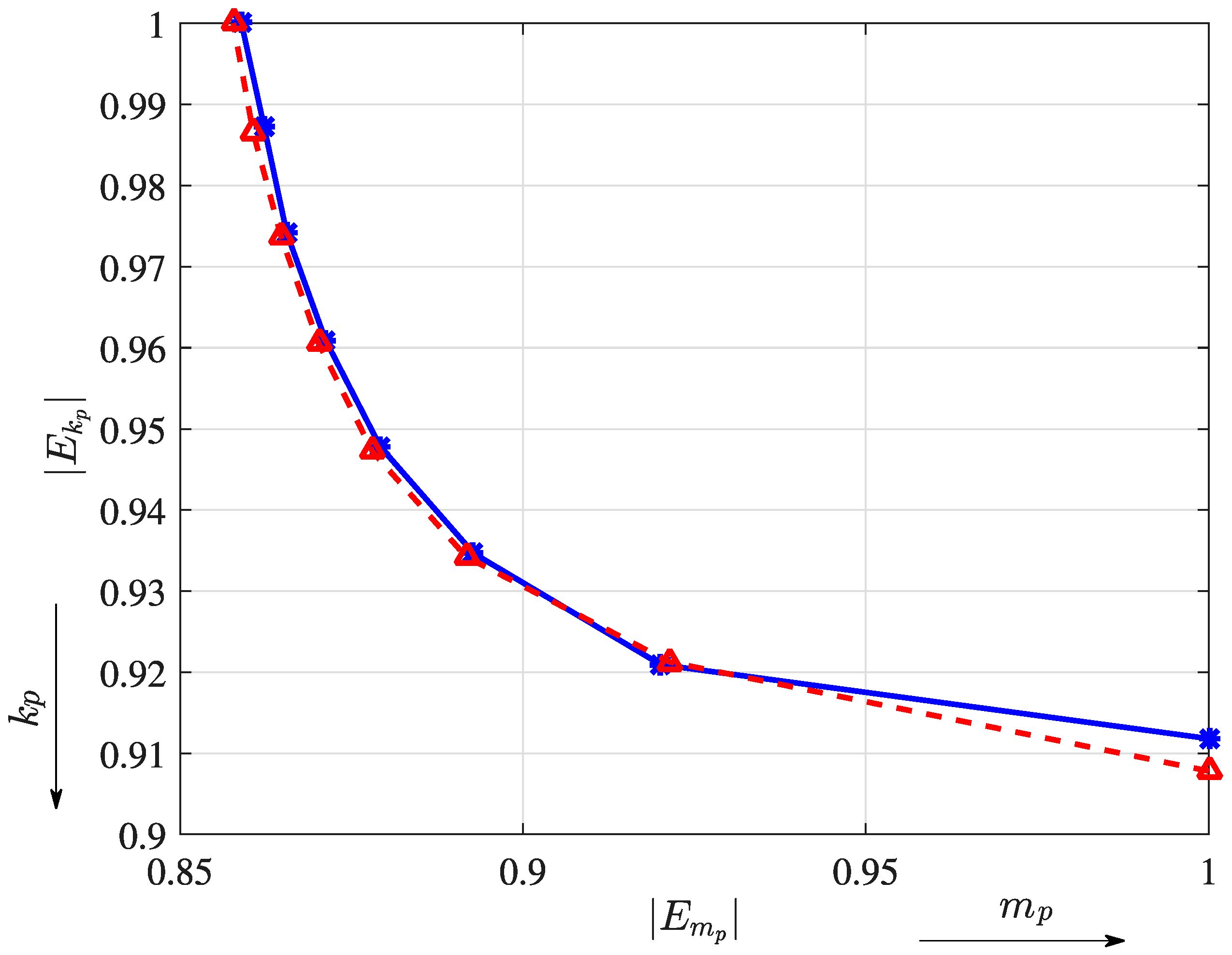

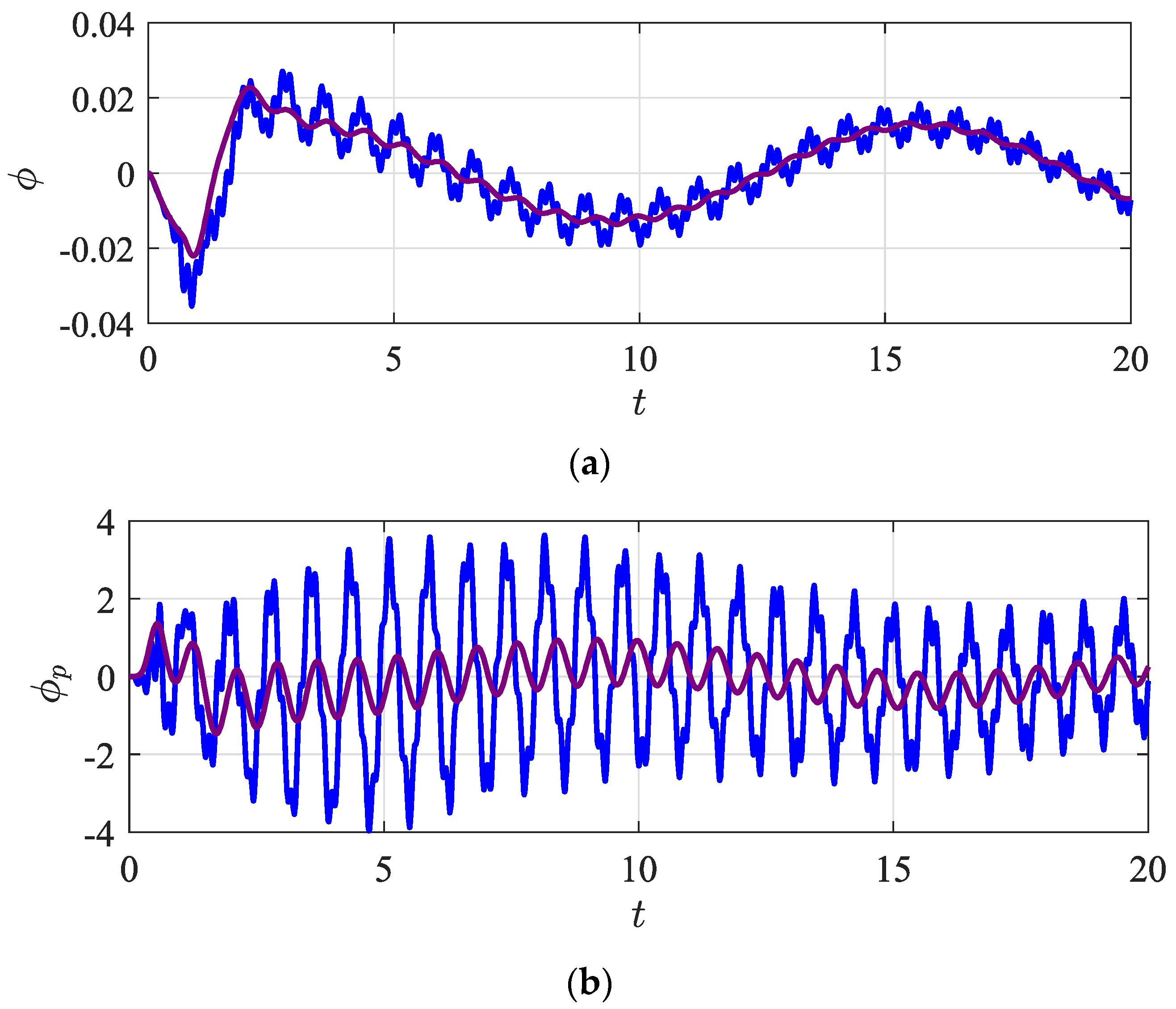
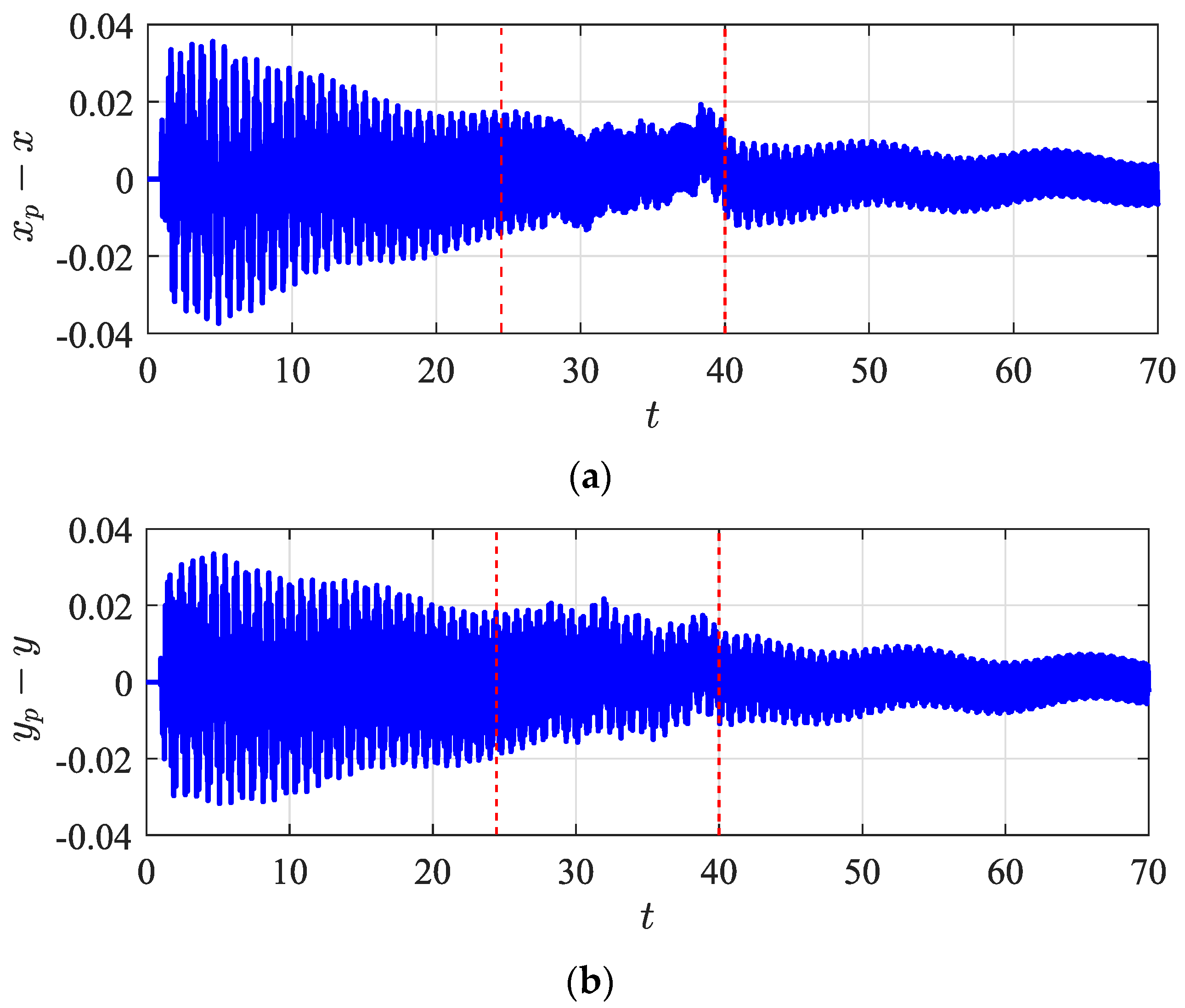
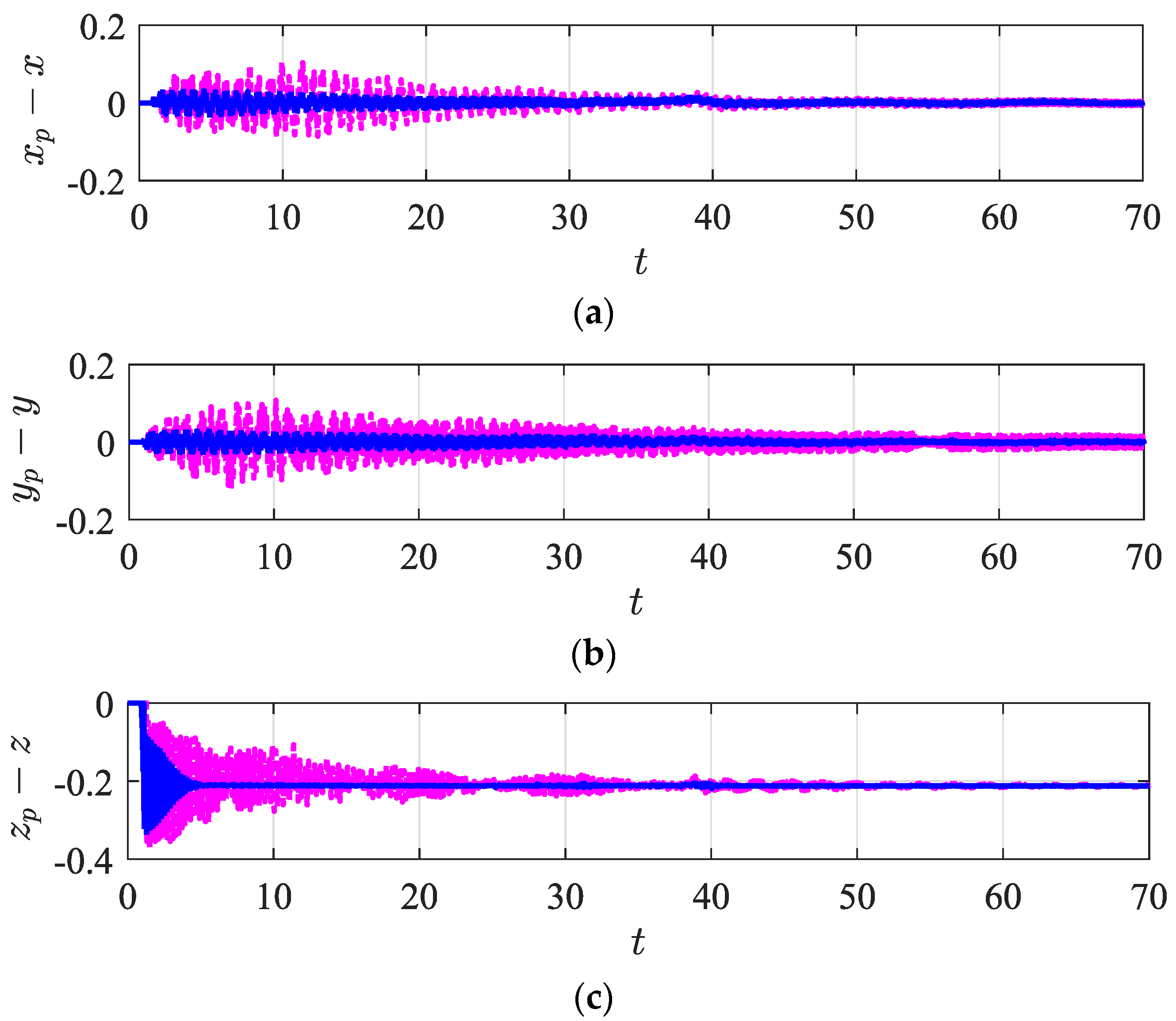

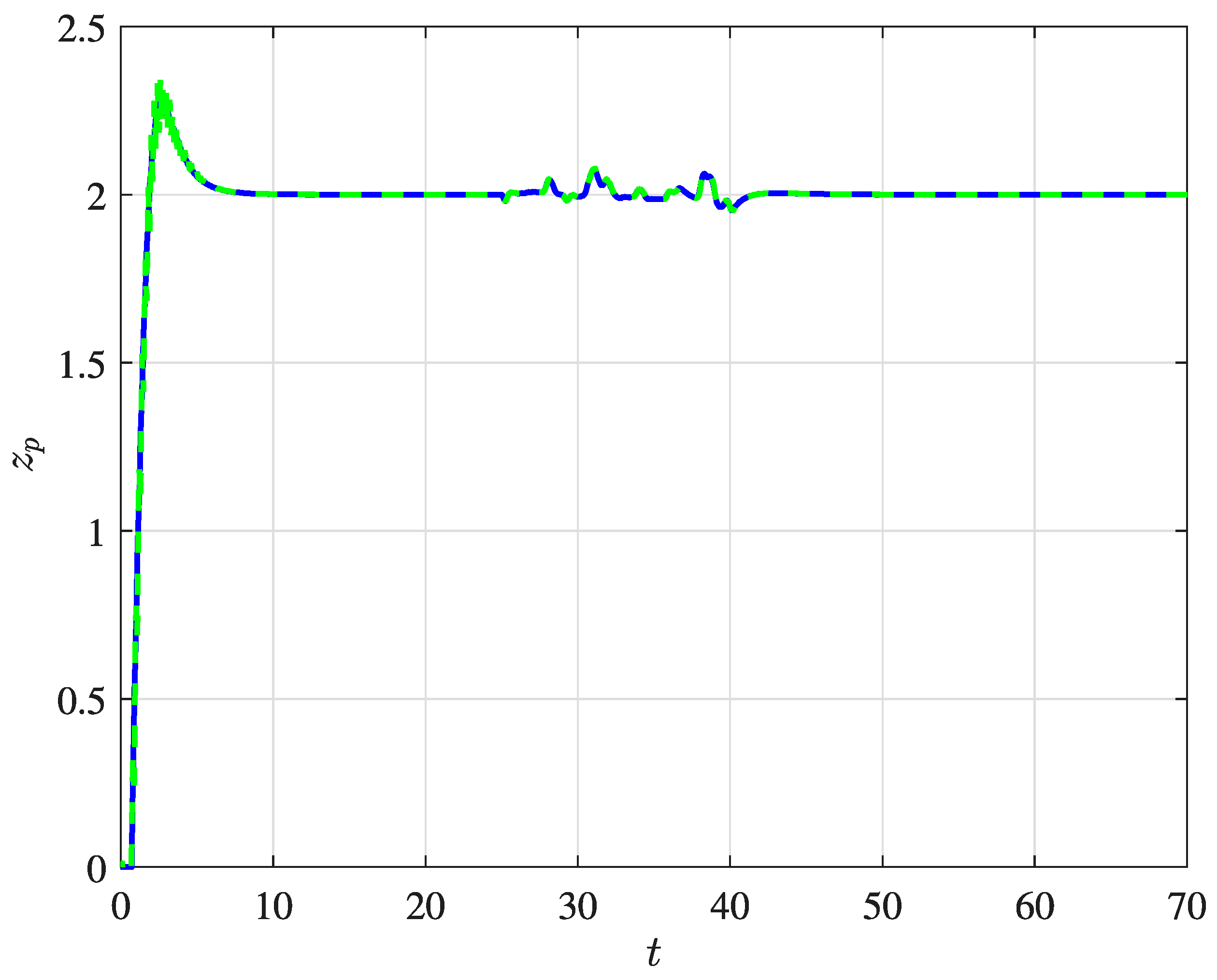
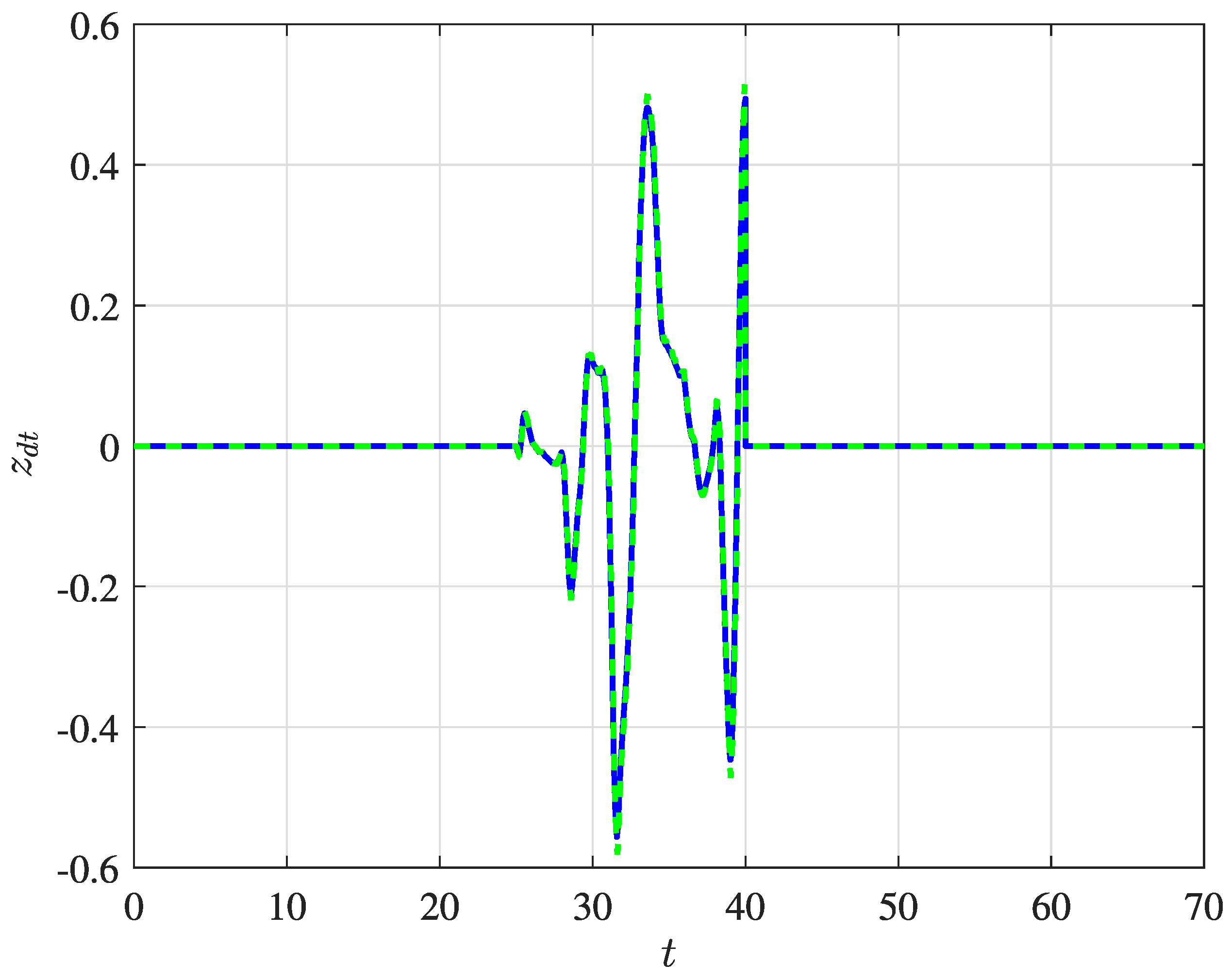
| Parameter | Value | Unit |
|---|---|---|
| m | 2.2 | kg |
| lb | 0.20 | m |
| g | 9.81 | m/s2 |
| Ix | 0.0167 | kg m2 |
| Iy | 0.167 | kg m2 |
| Iz | 0.0231 | kg m2 |
| Parameter | Value | Parameter | Value |
|---|---|---|---|
| 2.2, 1.8, 1.8 | 1.5, 1.1, 1.1 | ||
| 3.0, 3.2, 3.2 | 1.5, 1.5, 1.5 | ||
| 0.4, 0.4, 0.4 | 0.04, 0.04, 0.04 |
| pm | RT |
|---|---|
| 0.05 | 2.85 |
| 0.10 | 2.90 |
| 0.15 | 3.85 |
| 0.20 | 4.70 |
| 0.25 | 5.10 |
| 0.30 | 6.35 |
Publisher’s Note: MDPI stays neutral with regard to jurisdictional claims in published maps and institutional affiliations. |
© 2022 by the authors. Licensee MDPI, Basel, Switzerland. This article is an open access article distributed under the terms and conditions of the Creative Commons Attribution (CC BY) license (https://creativecommons.org/licenses/by/4.0/).
Share and Cite
Geronel, R.S.; Botez, R.M.; Bueno, D.D. On the Effect of Flexibility on the Dynamics of a Suspended Payload Carried by a Quadrotor. Designs 2022, 6, 31. https://doi.org/10.3390/designs6020031
Geronel RS, Botez RM, Bueno DD. On the Effect of Flexibility on the Dynamics of a Suspended Payload Carried by a Quadrotor. Designs. 2022; 6(2):31. https://doi.org/10.3390/designs6020031
Chicago/Turabian StyleGeronel, Renan S., Ruxandra M. Botez, and Douglas D. Bueno. 2022. "On the Effect of Flexibility on the Dynamics of a Suspended Payload Carried by a Quadrotor" Designs 6, no. 2: 31. https://doi.org/10.3390/designs6020031
APA StyleGeronel, R. S., Botez, R. M., & Bueno, D. D. (2022). On the Effect of Flexibility on the Dynamics of a Suspended Payload Carried by a Quadrotor. Designs, 6(2), 31. https://doi.org/10.3390/designs6020031








